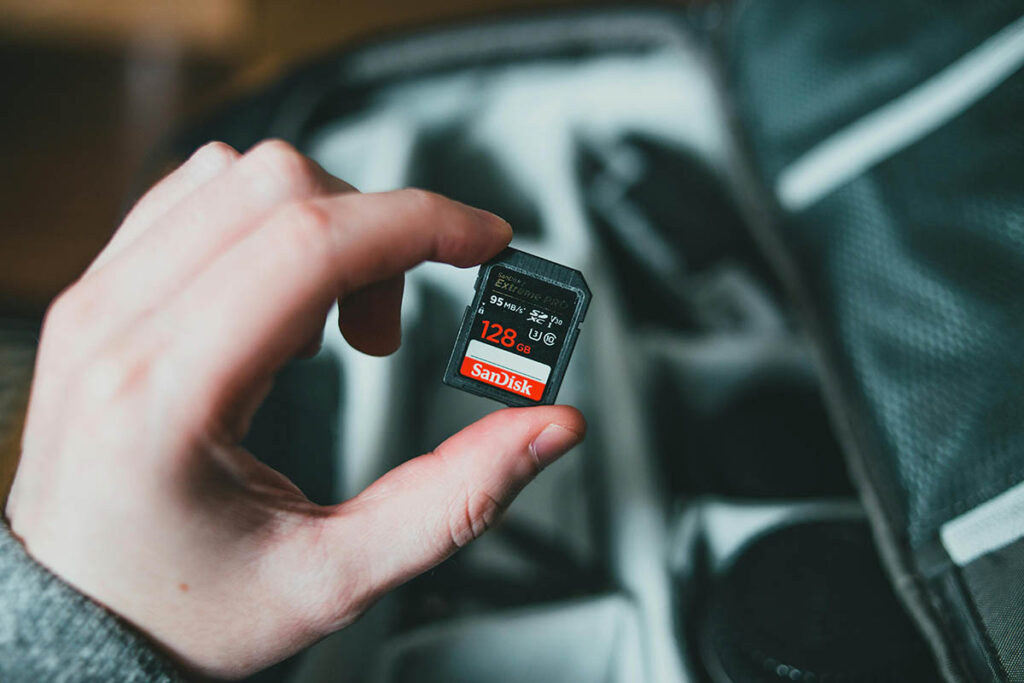Memory cards are essential components in modern photography, acting as the storage medium for your images and videos. This article will explore the mechanism, features, speed, advantages, disadvantages, utility, capacity, and recommendations for different types of memory cards based on various genres of photography.

What Are Memory Cards?
Memory cards are small, portable storage devices used to store digital data. They are widely used in cameras, smartphones, tablets, and other electronic devices to save photos, videos, and other files.
Mechanism of Memory Cards

Memory cards use flash memory to store data. Flash memory is a type of non-volatile storage, meaning it retains information even when the power is turned off. The basic components include:
- Controller: Manages data storage and retrieval.
- Flash Memory Chip: Stores the data.
- Connectors: Interface between the card and the device.
1. Storage Capacity
- Memory cards come in various capacities, ranging from a few gigabytes (GB) to several terabytes (TB). Common sizes include 32GB, 64GB, 128GB, and 256GB.
2. Speed Class
- Speed class indicates the minimum write speed of the memory card:
- Class 2: 2MB/s
- Class 4: 4MB/s
- Class 6: 6MB/s
- Class 10: 10MB/s
3. UHS Speed Class
- Ultra-High Speed (UHS) classes provide higher performance:
- UHS-I: Up to 104MB/s
- UHS-II: Up to 312MB/s
- UHS-III: Up to 624MB/s
4. Video Speed Class
- Indicates suitability for video recording:
- V6: 6MB/s
- V10: 10MB/s
- V30: 30MB/s
- V60: 60MB/s
- V90: 90MB/s
5. Durability
- Many memory cards are designed to be water-resistant, shockproof, and temperature-resistant to ensure reliability in various conditions.

Utility of Memory Cards
Memory cards are used in various devices and applications:
- Cameras: For storing photos and videos.
- Smartphones: To expand storage capacity.
- Tablets: For additional storage and transferring files.
- Computers: For data transfer and backup.
Advantages of Memory Cards
- Portability: Small and easy to carry.
- Compatibility: Used in a wide range of devices.
- Capacity Options: Available in various sizes to suit different needs.
- Reusability: Can be written and erased multiple times.
Disadvantages of Memory Cards
- Vulnerability: Can be easily lost or damaged.
- Data Corruption: Potential for data loss if the card is not properly handled.
- Compatibility Issues: Some cards may not be compatible with older devices.
Capacity Recommendations for Different Photography Genres
1. Portrait Photography
- Recommended Capacity: 32GB to 64GB
- Reason: Portrait sessions typically produce fewer images, so moderate capacity is sufficient.
2. Landscape Photography
- Recommended Capacity: 64GB to 128GB
- Reason: High-resolution images and extended shooting sessions require more storage.
3. Sports Photography
- Recommended Capacity: 128GB to 256GB
- Reason: High-speed continuous shooting generates a large volume of files.
4. Wedding Photography
- Recommended Capacity: 128GB to 256GB
- Reason: Capturing an entire event necessitates substantial storage.
5. Wildlife Photography
- Recommended Capacity: 128GB to 256GB
- Reason: Extended sessions and high-resolution images need ample space.
6. Videography
- Recommended Capacity: 256GB to 512GB+
- Reason: High-definition and 4K videos require significant storage space.

Capacity and speed recommendation for shooting
Choosing the right memory card for your photography needs involves considering both capacity and speed. Here are some recommendations based on different shooting scenarios:
1. Casual/Regular Shooting:
- For everyday photography, a 16GB to 32GB card is sufficient.
- Look for Class 10 or UHS-I cards with speeds starting at 30MB/s.
2. Enthusiast Shooting:
- If you’re into faster burst shooting and video recording, consider UHS-I cards with speeds of 60MB/s or higher.
3. Professional Shooting:
- For the fastest performance, opt for UHS-II cards with speeds exceeding 100MB/s or even high-end XQD cards.
Remember that storage capacity matters too. Filmmakers shooting high bitrate 4K, 6K, or 8K videos should consider cards with larger capacity, such as 64GB, 128GB, or 256GB
Suggested Types of Memory Cards
1. SD Cards (Secure Digital)
- Best for: General photography, most consumer cameras.
- Capacity: Up to 2TB
- Speed Classes: Class 2 to Class 10, UHS-I to UHS-III
2. MicroSD Cards
- Best for: Smartphones, action cameras, drones.
- Capacity: Up to 1TB
- Speed Classes: Class 2 to Class 10, UHS-I to UHS-III
3. CF Cards (CompactFlash)
- Best for: Professional cameras, high-speed photography.
- Capacity: Up to 512GB
- Speed Classes: Varies, generally higher speeds
4. XQD Cards
- Best for: High-end DSLRs and mirrorless cameras.
- Capacity: Up to 2TB
- Speed: Very high read/write speeds
5. CFexpress Cards
- Best for: Professional cameras needing ultra-fast speeds.
- Capacity: Up to 2TB
- Speed: Extremely high read/write speeds
Conclusion
Choosing the right memory card is crucial for ensuring a smooth and efficient photography experience. Consider the capacity, speed, and durability that best fit your specific photography needs. Whether you’re capturing portraits, landscapes, or videos, there’s a memory card designed to meet your requirements.
